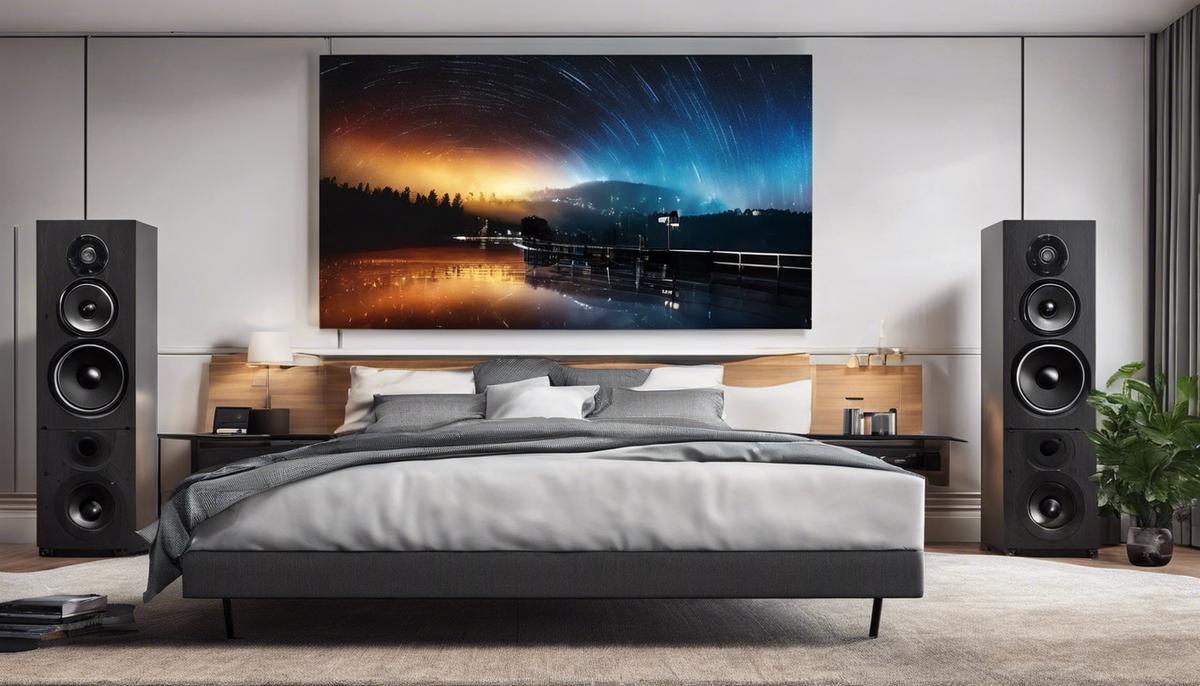The often neglected domain of audio systems encompasses a world rich in complexity and intricacies. When confronted with a mysteriously malfunctioning sound apparatus, the problem frequently lies within the realm of buzz, hum, and interference. Yet, the layperson, and even some audio enthusiasts, lack the proper understanding to discern amongst these different forms of audio interference. As we delve into the intricate causeways of your audio infrastructure, we shall first equip you with knowledge to differentiate between various types of audio disturbance. Then, we will guide you on your journey through troubleshooting cable issues with an assortment of techniques and tools. Finally, you will learn practical solutions to resolve common audio interference problems,
Identifying Different Types of Audio Interference
Humming beneath the symphony of life, music weaves its mesmerizing melodies – a siren call to the ears and souls of millions worldwide. Yet, the beauty of this sonic enchantment can be painfully disrupted – pierced by the grating, jarring incongruence of audio interference. Be it the hiccup in the melody of your favorite record, the howl interrupting a life-altering music festival performance, or the feedback bringing your own sonic masterpiece recording to a screechy halt, these uninvited intruders are the bane of any music lover’s existence. It’s time we demystify these unwelcome guests, break them down and explore their essence.
Get ready for a journey down the audio rabbit hole, as we dive into the key types of audio interference.
One can hardly talk about audio interference without bringing up the prevalent Radio Frequency Interference (RFI). It’s that insistent, unwanted guest at the party, made more readily identifiable by that characteristic crackling or high-pitched whining. RFI finds its devious roots in varying sources – from the omnipresent cell phone, innocuous Wi-Fi equipment, to seemingly harmless dimmer switches or LED lights.
Next, we grapple with the irritating buzz of the Ground Loop Hum. Its pervasive drone is unmistakable – a product born of different audio components sharing the same ground point. It’s that persistent uninvited drone that threatens to swallow up the intricate layers of harmonious conversations unfolding in the audio domain.
Then enters the distorted step-cousin, Acoustic Feedback. This offender often has you cringing at live concerts. That spine-chilling wail, the howl that sends piercing shivers down your spine, is most likely Acoustic Feedback. Nurtured in the high volume surroundings of live performance spaces, feedback unfurls when the sound from the speakers reaches the microphone, and a menacing loop is born.
While interference may seem like the phantom of the audio world, out to shatter our aural dreams, remember, all is not lost. Treasures beckon in the form of counter-measures – shielding, balanced connections, optimal layout and setup – each a knight poised to ward off the interference demons.
Head high, soul ablaze, step forth and embrace your bond – your passion for music. Together, we’ll continue to cherish this love for rhythm and melody, transcending boundaries, exploring the ethereal power of sound… And yes, triumphantly banishing audio interference to the realm where it belongs – a shrugging footnote in the symphony of life.

Troubleshooting Audio Cable Problems
All electrical devices have the potential to add unwanted noise to your audio system. For the music aficionado, achieving pristine, interference-free sound is truly an endeavor of heart and soul. This journey can sometimes feel like navigating a labyrinth. However, by understanding the essential steps for troubleshooting audio cable problems, we can revel in the immaculate purity of sound that we crave.
When you detect a buzzing, humming, or interference in your sound system, an incorrect setting or faulty cable is often the culprit. The first and most fundamental step is to disconnect your audio equipment, leaving only the amplifier and speakers connected. Turn the system on. If the noise continues, the problem lies within the amplifier or speakers.
If the noise ceases, reconnect each piece of equipment one by one, checking for noise after each connection. This process of elimination can isolate the source of the buzzing or humming. Once identified, consider changing the cable for that piece of equipment, as it can be a significant cause of interference.
Radio Frequency Interference can be caused by other electronic devices placed close to your audio connection. Based on our prior RFI knowledge, take heed of additional household appliances or electronic devices. Staying mindful of their interference will only help to amplify our love for the rhythm and harmony, intertwining the wires of melodic unity with a minimum of ruffled feathers.
Remember, cables transmit signals just like paths in a forest transmit foot-traffic. Pathways winding too closely together might disturb each other. As a music devotee, try to ensure that your signal cables and power cables aren’t organizationally entangled. When power cables lie close to the audio or speaker wires, they can induce a hum into the music signal. The interference essentially acts as an uninvited guest, disrupting the harmonious symphony of sound.
Another common enemy of clear sound is the Ground Loop Hum. This sonic vampire is best battled by ensuring all your audio equipment shares the same power point. By doing so, you will keep the electrical potential between them at the same level, reducing the chances of undesired sounds.
Acoustic feedback, that unsettling screeching, typically occurs during live performances. The proximity of the microphone to the speakers greatly influences feedback. Distance your microphone from the speakers and keep it pointed away, thereby reducing the intensive feedback loop, louder than any shouting match.
Along this auditory journey, it’s essential to understand and acknowledge the beauty in the struggle. It’s this very struggle that breeds the sweetest harmony, echoing through the myriad tunnels of life. There’s a profound intimacy in sound, linking souls across time and space – and its preservation isn’t just a labor of love, but a commitment to the expressional power of awesome soundscapes.
Let us all continue to persevere through the noise and strife for the triumphant, life-affirming harmony beyond. Through understanding, patience, and a little troubleshooting, we’ll minimize interference, and maximize the sheer and ethereal beauty that is music, expressed through the dance of electronic signals in our much-loved audio appliances.

Fixing Buzz, Hum, and Interference
The essence of music lies not only in the notes themselves but in the spaces between them – in the silence where the echoes of melodies resonate. But when this precious silence is invaded by audio interference and cable problems, our deep connection with music is disrupted. To champion the enduring love for music, one must effectively navigate these sonic challenges. Specific causes of cable-related audio disturbances need appropriate proven solutions to restore the purity of sound, and thus, its emotional language.
Audio interference caused by cable problems can often be traced back to physical damages. Jacks can come loose, cables can be frayed, and in some cases, they may be entirely broken. In such instances, consider replacing the flawed parts. It’s crucial to ensure your audio gear is always in top shape to broadcast the music, untarnished by unwanted noise.
In the presence of an unknown cause, a process of elimination is essential. Starting with the obvious – ensuring all the cables are correctly plugged. Unplugging and re-plugging can also clear any momentary glitches in the system. Keeping your signal cables and power cables separated can prevent interference from electromagnetic fields.
Humming noises coming from cables may attribute to a ground loop. This occurs when there is more than one path to ground. While it can be tempting to remove the grounding pin from the plug to solve this issue, this is a dangerous approach that should be avoided. Instead, consider a ground loop isolator – a small device that can prevent electrical current from flowing down unwanted paths.
Interference from other electronic devices nearby has the potential to wreak havoc on your music experience. A useful measure is to turn off electronic devices not necessary for your music session, creating an environment free from unnecessary electronic activities – a sanctuary for your sonic expressiveness.
Cable organization is not merely about aesthetics, but it plays a significant role in preventing interference. Neatly routing and securing your audio cables, physically separating them from power cables can drastically reduce the chances of audio interference, establishing clean paths for unhindered music transmission.
Feedback can often be derived from incorrect placement of microphones relative to speakers in live performances. Maintaining the right distance and orientation of the microphone from the speaker can minimize this. Additionally, a high pass filter reduces low-frequency signals more prone to feedback.
Grasping the passion for music means more than just enjoying melodies and rhythms. It implies a fight against all the elements risking this sonic purity – combatting audio interference becomes a melodic crusade. Every beat, note, and silence deserves to be heard without the interruption of cable glitches and interferences. In the face of every sonic challenge lies the opportunity to deepen our relationship with music, and triumph over interference. This victory ensures that the profound, emotional language of music continues to unite, soothe, and inspire.

Photo by unstable_affliction on Unsplash
Having traversed the complexities of audio system interference and the conundrums that come with it, you are now empowered with the skills to diagnose, troubleshoot, and resolve issues within your system. The journey from understanding the distinct types of interferences to learning about practical solutions for these issues equips you to enhance your audio experience and rectifies common challenges. But remember, the key is patience, observation, and constant learning. With time, even the elusive world of audio interference will become a familiar landscape ready to be mastered. Remember this knowledge not as an end, but as a stepping stone towards your pursuit of sonic perfection.

Comments.
Currently there are no comments related to this article. You have a special honor to be the first commenter. Thanks!